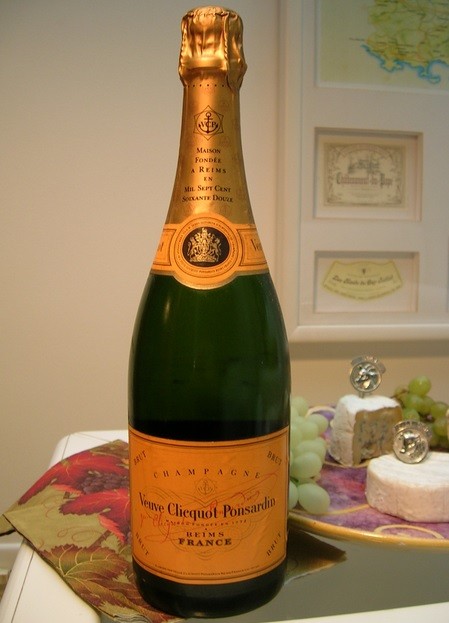170 Year-Old Champagne Recovered from Shipwreck: Super Sweet with Iron and Copper Elements
| Ana Verayo | | Apr 21, 2015 09:13 AM EDT |
(Photo : Wikipedia) The modern version of the 170 year old Veuve-Clicquot Ponsardin champagne.
Scientists have discovered 170 year-old champagne bottles inside a shipwreck at the bottom of the Baltic Sea and claim the champagne still tastes pretty good.
The French bubbly is presumed to be the oldest wine ever tasted and even if it was terribly sweet, it also presented aromas of leather, tobacco and smoke.
Like Us on Facebook
French researchers have released their chemical analysis of the champagne five years after 168 pristine bottles were discovered by scuba divers off the Finnish coastline in 2010.
Lead author Philippe Jeandet, a biochemist from the University of Reims, didn't get to drink any of the vintage samples but noted even a tiny whiff from those vintage bubbly tickled his nose for a period of seven hours.
Jeandet says some 100 microliters was placed on his hand by a micro syringe. He described the taste as marvelous. The aroma smelled like tobacco and remained in his mouth for two to three hours, saying that it was remarkable.
Jeandet also revealed the champagne also contained iron and copper elements. The iron most likely originated from the nails of the wooden barrels used to age the wine before bottling them. The copper, on the other hand, is from copper sulfate that was necessary to kill fungus and mildew on grape vines.
Modern champagne is now stored in stainless steel vats before being bottled. The team also discovered a small amount of gelatin, which is a protein used to stabilize and precipitate the wine.
The bottles were discovered some 165 feet deep in a cargo ship that sank off the Aland Islands in Finland. The temperature of the sea bottom was just a few degrees above freezing point, which was pivotal in preserving the champagne.
Even after 170 years, the corks also didn't disintegrate since the bottles are designed to withstand any pressure from carbonation. These champagne corks are also denser that regular wine cork, said Andrew Waterhouse, a professor of enology from the University of California.
Waterhouse also revealed that the sweetness of the champagne originates from the French champagne houses of Veuve-Clicquot Ponsardin and Heisdeck. The champagne was in transit to Russia or Northern Germany when the ship sank between 1832 to 1838.
During an auction in 2012, 11 bottles of the Veuve Clicquot Ponsardin from this shipwreck were sold for US$156,000. This study was published in the journal, Proceedings of the National Academy of Sciences.
TagsFrench champagne, shipwreck champagne 170 year old, 170 year old champagne shipwreck, Baltic Sea, Finland, Veuve Cliquot Ponsardin, Champagne, wine, oldest champagne taste
©2015 Chinatopix All rights reserved. Do not reproduce without permission
EDITOR'S PICKS
-

Did the Trump administration just announce plans for a trade war with ‘hostile’ China and Russia?
-

US Senate passes Taiwan travel bill slammed by China
-

As Yan Sihong’s family grieves, here are other Chinese students who went missing abroad. Some have never been found
-

Beijing blasts Western critics who ‘smear China’ with the term sharp power
-

China Envoy Seeks to Defuse Tensions With U.S. as a Trade War Brews
-

Singapore's Deputy PM Provides Bitcoin Vote of Confidence Amid China's Blanket Bans
-

China warns investors over risks in overseas virtual currency trading
-

Chinese government most trustworthy: survey
-

Kashima Antlers On Course For Back-To-Back Titles
MOST POPULAR
LATEST NEWS
Zhou Yongkang: China's Former Security Chief Sentenced to Life in Prison

China's former Chief of the Ministry of Public Security, Zhou Yongkang, has been given a life sentence after he was found guilty of abusing his office, bribery and deliberately ... Full Article
TRENDING STORY

China Pork Prices Expected to Stabilize As The Supplies Recover

Elephone P9000 Smartphone is now on Sale on Amazon India

There's a Big Chance Cliffhangers Won't Still Be Resolved When Grey's Anatomy Season 13 Returns

Supreme Court Ruled on Samsung vs Apple Dispute for Patent Infringement

Microsoft Surface Pro 5 Rumors and Release Date: What is the Latest?










